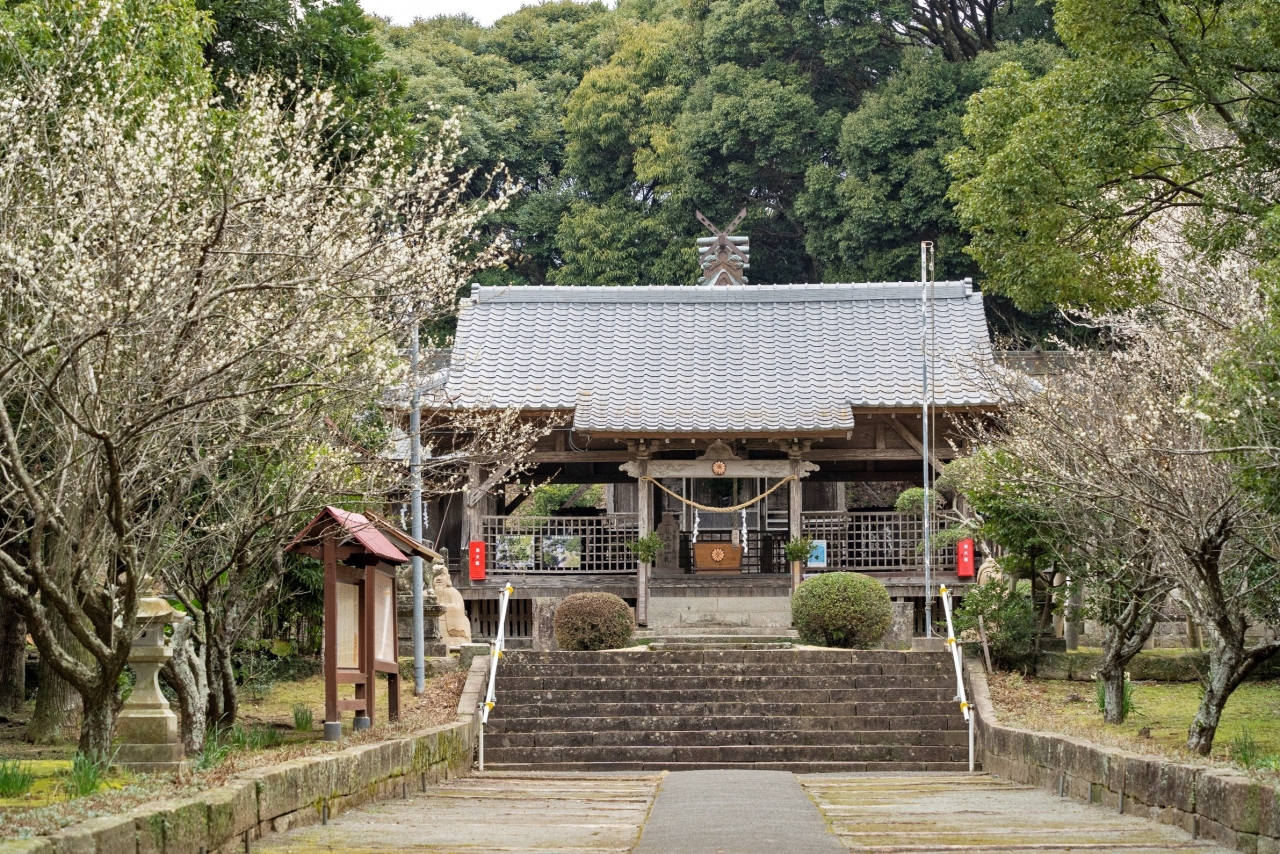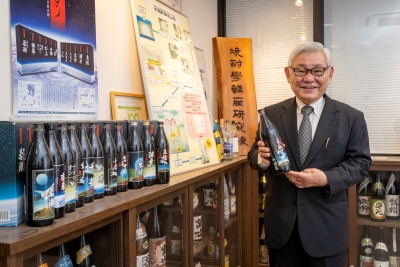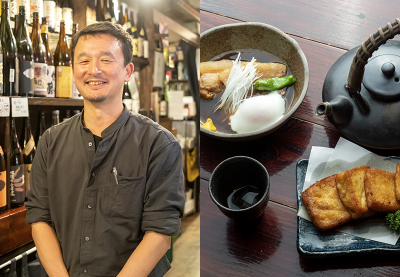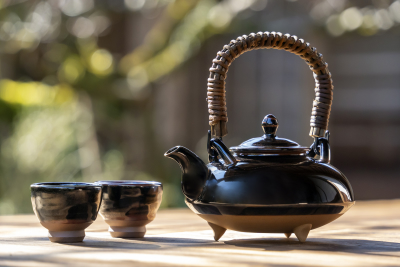A Pioneering Spirit to Spread Satsuma Shochu Worldwide―Satsuma

The stories of the dieties at Takaya Shrine in Minamisatsuma City, Kagoshima Prefecture, are said to have foretold the birth and development of shochu in Kagoshima, and as such the shrine has come to be known as the Shochu Shrine. Traditionally, Kagoshima has not been suitable to rice cultivation—and in turn sake production—due to its high temperatures, high humidity, frequent typhoons, and volcanic soil. During the rule of the Satsuma clan in the mid-Edo period, however, the sweet potato shochu production flourished as a local culture with the arrival of sweet potatoes. From then onward, the industry has overcome the area’s unfavorable geographical conditions by incorporating techniques from overseas, such as unique distillation methods and the use of black koji mold. Doing so helped to develop a unique sweet potato shochu. Toward the end of the Edo period, the Satsuma clan produced many outstanding individuals who helped to drive the modernization of Japan. A pioneering spirit of boldly taking on difficult challenges and creating a new era without being bound by precedent is firmly rooted in this region. Today, the endeavors of various shochu distilleries and their initiatives with local communities are helping to spread the charms of Satsuma Shochu worldwide.
Unique Regional Characteristics
“Throughout world history, Satsuma is the only region to have used sweet potatoes to produce alcohol for the common people,” says Yoshihiro Sameshima, a visiting professor at Kagoshima University. After graduating university, Sameshima spent some time at Nikka Whisky before joining Satsuma Shuzo. Following concurrent roles as managing director, director of research, and general manager of the production division, today Sameshima teaches shochu production at Kagoshima University’s Education and Research Center for Fermentation Studies.
Protecting Tradition and Developing New Markets through Barrel Storage 【Satsuma Shuzo】
Satsuma Shuzo is a shochu distillery founded in 1936. It was the first company to ship Satsuma Shochu outside of Kagoshima Prefecture. It was also a leading presence behind the first shochu boom through a catchphrase of mixing shochu and hot water at a ratio of 6:4. Representative brands of shochu are Satsuma Shiranami and Kannoko, both of which are well-known across Japan. Currently, Satsuma Shuzo has three distilleries and a bottling factory, where it is working to automate the bottling process. While supplying a diverse range of products nationwide—including sweet potato shochu, barley shochu, liqueur, and happoshu beer—Satsuma Shuzo also uses diverse production methods. For example, in a warehouse that has been in existence since the Meiji era, they continue to maintain traditional production methods, using earthenware pots more than a century old for the fermentation process.
“Based on our ‘MAKE a WAVE’ vision, while valuing tradition, we are incorporating new ideas and techniques to explore the possibilities of manufacturing,” says Masakatsu Takeyama, general manager of Satsuma Shuzo’s production division. One result of this exploration is the well-aged shochu “Kannoko”, which won the Platinum Award in the Barrel Storage Category of the 2021 Kura Master Awards. As consumption of barley shochu increased amid the second shochu boom, Satsuma Shochu came up with the idea to store its barley shochu in barrels to add value.
Because of its commitment to quality, Satsuma Shuzo is the only shochu distillery to have its own barrel cellar and barrel workshop. Today, three expert craftsmen are in charge of maintenance, modifications, and the manufacture of new barrels. In charge of barrel-related operations is Tomohiro Iwaizako, who says enthusiastically, “Our main job is to modify and maintain the many barrels we manage in the workshop to ensure there are leak-free. To create the shochu of ideal quality, we have to envisage the flavors after storage. We therefore have to carefully select the material, shape, and size of the barrels, and carefully adjust the degree of recharring, a process which involves baking the interior to activate the barrels. Ensuring zero leakage is a matter of course. Our goal is to produce shochu that will delight our customers by maximizing the potential of the barrels. We want to communicate the charms of well-aged shochu, which are entirely different to those of whisky.”
It is said that there are only 60 to 70 so-called barrel craftsmen nationwide. In this way, Satsuma Shuzo is successfully carrying on valuable techniques.
[Satsuma Shuzo website: https://www.satsuma.co.jp/english/index.html ]
Development of a New Shochu Made from Chiran Tea and Chiran Sweet Potatoes 【Chiran Jozo】
The Chiran Jozo distillery is located in Chiran Town in Minamikyushu City. In addition to being a famous area for sweet potato production, Chiran Town is also one of Japan’s leading tea-producing areas. Chiran Jozo was established in 1919. With its own tea plantation and produces both shochu and tea, Chiran Jozo is said to be an outlier in the town. Nobiru Mori is the fourth-generation head of Chiran Jozo. After taking over the company, Mori was busy for a while with the shochu boom. When this abated, he decided to consider the future of the industry.
“With bottled tea becoming mainstream, tea leaf consumption had fallen and so had its price. Shochu consumption was also falling, and so for a long time I thought about various solutions,” says Mori.
The turning point came when he attended a workshop at a restaurant. Here, he poured hot shochu into a teapot with full of tea leaves and let them steep. He then poured this over ice. Mori was shocked by its delicious taste.
“I knew the flavor had potential and I wanted to promote it far and wide,” he says.
Following more than seven years of trial and error to produce a shochu with the aroma of tea, Mori successfully developed a production method which involved adding tea leaves to the mash. To generate an original aroma, Mori himself created a unique blend using only the first harvest of tea leaves from the company’s own plantation. Finally, in 2018, Chiran Jozo released Chiran Tea-Chu, made from local Kogane Sengan sweet potatoes and Chiran tea leaves. In 2021, Chiran Tea-Chu won the Gold Award in the Shochu Category at the Tokyo Whisky & Spirits Competition for the second consecutive year. It has also received high acclaim overseas. At the 2021 Kura Master Awards, for example, the product won the Platinum Award, the Jury Award, and the President’s Award, the highest accolade in the Sweet Potato Shochu Category.
According to Mori, the words “produce with your senses, not with machines” have been passed down from generation to generation by previous chief distillers at Chiran Jozo. Unless shochu is produced with the distiller’s five senses, its quality will not be communicated to the customer. It can be said that this inherited passion has led to the development of Chiran Tea-Chu as a product unique to Chiran Jozo.
“Minamikyushu City is the largest producer of tea and sweet potatoes in Japan. It would be great if we could communicate the appeals of Chiran tea to the world alongside Satsuma Shochu,” says Mori. In addition to Thailand, the U.S., and France, with the support of JETRO, Chiran Jozo has also begun exporting its products to Taiwan and Hong Kong. In December 2022, Chiran Jozo launched a roasted tea version of Chiran Tea-Chu. With his thorough knowledge of tea and shochu, Mori’s endeavors are set to continue.
[Chiran Jozo website: https://chiranjozo.co.jp/ ]
Developing Shochu into the World’s Leading Alcoholic Drink Breaking Convention through Enhancing the Specific Shochu Aroma 【Hamada Syuzou】
Hamada Syuzou was established in 1868. Today Hamada Syuzou has three distilleries in Ichikikushikino City with different concepts: the Denbeegura distillery, which values tradition; the Denzouingura distillery, which strives for innovation; and the Kinzangura distillery, which focuses on the succession of traditional techniques. In line with the concept of each, Hamada Syuzou produces a diverse range of shochu products. Prior to the company’s 150th anniversary in 2018, the president set his employees the task of developing a next-generation shochu that was clearly different from anything else. After much discussion, the development team focused on the unique lychee-like aroma of sweet potatoes.
Manager of the Blending Department Eisaku Ozono says, “There are many different aromatic components of sweet potatoes that produce the distinctive aroma of sweet potato shochu. Conventionally, the industry norm has been to remove these aromas to create a final product that is easy to drink. Focusing on and sharpening one aroma was technologically very difficult.” Trial and error resulted in the highly aromatic Kokjuku-imo sweet potato was created through a proprietary maturation process. “To control and produce this lychee-like aroma, we pay attention to every detail in our own meticulous production process, such as selecting the koji mold, yeast, and fermentation temperature for the Kojuku-imo,” says Daichi Takezako, general manager of the Development Department.
The final result of a shared and united desire among employees to create a shochu unique to Hamada Syuzou was the creation of DAIYAME, a shochu distinctive for its flowery, lychee-like aroma.
In 2019, DAIYAME won the top prize in the Shochu Category at the International Wine & Spirit Competition, and in 2020 it won the Double Gold Award at the International Spirits Challenge. Members of the Wine & Spirit Education Trust, an organization based on London that certifies wine, spirit, and sake qualifications, have called DAIYAME the gateway to the world of Honkaku Shochu. Hamada Syuzou began exporting DAIYAME to the U.S. in March 2023, and has also developed DAIYAME 40 with a higher alcohol content of 40% for overseas markets. “In the West, distilled liquor is consumed before and after meals. Since Shochu is a mealtime beverage, it is unlikely to be accepted overseas as it is. Beginning to drink it in a cocktail base, my aim is to communicate the outstanding aroma and quality of Honkaku Shochu, mainly DAIYAME, to people in other countries,” says Tomoya Hiraishi of the Marketing Division. At the company’s monthly new product development project meetings, all involved are working to develop elevated products to wow consumers once more.
[Hamada Shuzo website: https://www.hamadasyuzou.co.jp/en/ ]
Maewari Culture 【Maewariya】 and Satsuma Liquor Vessels Kuro-joka 【Chin Jukan Kiln】
One unique way of drinking Satsuma Shochu to further highlight its qualities is maewari. For further enjoyment, this maewari shochu is warmed over low heat in a black pot known as a kuro-joka, which brings out the umami of the shochu.
Maewari is the blending of shochu with water prior to its consumption. Traditionally, water is added to shochu the day before customers drink it and left overnight. It is a method developed in Satsuma to make shochu in the optimal condition for drinking.
Akihito Ota is a Shochu Meister who graduated in the fourth term, and is the representative of Maewariya restaurant. Using his expertise he provides advice on the characteristics of each brand and the best way to drink it. “Our maewari blend is comparatively strong. We use shochu to water ratio of 5.7:4.3. We blend the shochu and water around two weeks in advance, which enables the alcohol and water molecules to mix and create a smoother flavor,” says Ota.
Maewariya offers various drinking styles—such as maewari highball, in which maewari is mixed with carbonated soda, maewari on the rocks, and warm maewari—paired with local Satsuma cuisine such as fried fishcake and braised black pork belly. The shochu is served in kuro-joka pots, which are unique to the Satsuma region, and adored by customers from both inside and outside Japan.
These kuro-joka pots are made at many potteries in Kagoshima. The Chin Jukan Kiln has continued to pursue the beauty of Satsuma ware since 1598, when it was under the patronage of the Shimazu family as its official kiln. Today, it is a leading kiln of Satsuma ware, which is designated as a traditional Japanese craft. The kuro-joka pots from the Chin Jukan kiln are characterized by their round shape, which recreates the shapes of pots discovered near Miyama (then called Naeshirogawa). Today, the kiln is engaged in various activities to improve the value of Satsuma Shochu. For example, they have improved the quality of the clay so that it radiates far infrared rays, and worked with distilleries to create shochu bottles and cups.
“Ceramics are fired at around 1,260 degrees Celsius, which causes them to shrink. The more difficult the workmanship, the more likely the ceramics are to be damaged in the process. The Chin Jukan approach to manufacturing is to confront this risk and keep taking on new challenges,” says Toshinori Segawa of the PR Department.
Alongside traditional techniques, Chin Jukan carries on the pioneering spirit of Satsuma.
[Maewariya website: https://x.gd/5Q20O ]
[Chin Jukan Kiln website: http://www.chin-jukan.co.jp/introduction.html ]












